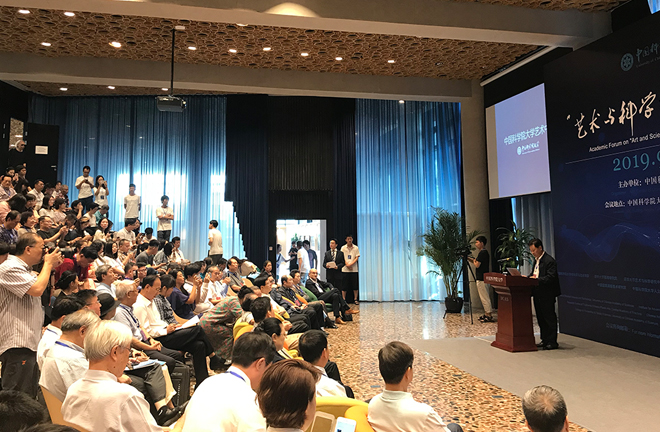Cultivating top talent requires interdisciplinary art and science

Scholars discussed the relationship between art and science at the Academic Forum on “Art and Science: Crossing Disciplinary Borders.” Photo: Chu Guofei/CSST
Qian Xuesen (1911–2009) was a world-famous aerodynamicist and he was honored as “father of China’s aerospace” and “king of rockets.” His question of “why China’s schools have always failed to cultivate top talent” is known as “Qian’s Doubt.” Zhong Chengxiang, chairman of China Literature and Art Critics Association, said at the Academic Forum on “Art and Science: Crossing Disciplinary Borders” that the key to Qian’s Doubt is the handling of the relationship between science and art. Scientific thinking explores objective laws and seeks the truth of the world; artistic thinking attempts to grasp the world with creative aesthetics. For a long time, science and art have been in a state of mutual exclusion. Scientific thinking often suppresses or even restricts artistic thinking; in turn, artistic thinking emphasizes its independence and uncertainty. However, Qian proposed that the two should not be mutually exclusive, but complement each other and progress together.
More than 120 experts and scholars at home and abroad attended the forum on Sept. 7–8 sponsored by University of Chinese Academy of Sciences (UCAS). They attempted to transform Qian’s Doubt into a question with a more specific nature, namely, the relationship between art and science.
Li Shushen, vice president of Chinese Academy of Sciences and president of UCAS, said that the establishment of the UCAS Arts Center is of great significance in improving the artistic literacy and innovation ability of China’s future scientists. The Arts Center aims to emulate world-class universities to cultivate first-class innovative talent for the country.
Tsung-Dao Lee once said that science and art are two sides of a coin and the combination of the two could greatly inspire artistic creation while promoting innovation in scientific research. Wang Cizhao, deputy director-general of the Art Education Committee of the Ministry of Education and former president of Central Conservatory of Music, said that the development of the two disciplines is based on a common psychological power—the human imagination. With imagination as a go-between, art and science foster human creativity, and together create human spiritual and material civilizations.
Han Ziyong, president and Party secretary of Chinese National Academy of Arts, said that the rapid development of science and technology has broadened many fields that predecessors have not been involved in. At present, many important scientific and technological tasks and goals have far exceeded the existing disciplinary boundaries. The time of “non-interference” among different disciplines has gone. Disciplines that were totally unrelated in the past may actually have closer connections now, and experts of different areas may need to sit together to exchange views. Those who break disciplinary borders and integrate knowledge of different fields earlier are most likely to discover a new world.
Lu Yushun, executive vice president of China National Academy of Painting, said that how to view the relationship between science and art will directly impact their trends of development and the future cultivation of talent. We are now living in an interconnected era with everything interactive not only in life, but in the scientific community as well. As early as in the 1990s, Yale, Harvard and other world-class universities and institutions have been committed to training programs for first-class talent in the 21st century. They share the same educational goal, to cultivate generalists. As such, in recent years, domestic colleges and universities have also been engaged in liberal education for compound talent. It is probable that future society will be increasingly competitive, with more challenges and possibilities. As two basic areas of human development, art and science explore the unknown world in different ways, but under the influence of modern technologies and modern thinking, their interdisciplinary development will present new opportunities.
Early in the 1980s, CAS proposed to cross disciplinary borders and achieve the integrated development of science and art. Qian Xuesen, Chen Ning Yang, Tsung-Dao Lee and many other scientists discussed with artists such as Wu Guanzhong on how to cultivate world-class talent through the interdisciplinary development of science and art. In this new era, China shoulders the important mission of cultivating integrated talent for the country. An interdisciplinary education of art and science will inspire the continued vitality of scientific research and artistic creation.
edited by YANG LANLAN

 PRINT
PRINT CLOSE
CLOSE